Abandoned shopping carts are among the most frustrating obstacles to success for eCommerce brands.
You worked hard to get that customer to your site — maybe even paid for an expensive click from Facebook or Google. They navigated your carefully designed category and product pages full of enticing images and compelling content. They considered buying and put your product in their cart, only to walk away at final checkout.
Why?
The answer is clear: Unexpected shipping costs are the number one reason for cart abandonment.

If you don’t want to lose potential customers at this point, you need to have attractive shipping and return policies.
Does that mean you should always offer free shipping? Maybe… and maybe not.
Our 2024 Best in Class Report reveals that the top online businesses take several different approaches to the issues of shipping and returns, showing several possibilities for your business.
In this blog, we’ll explain:
- How Amazon Prime has changed the eCommerce shopping experience forever
- What our annual Best in Class Report reveals about shipping and return trends among top online retailers
- What we recommend for online stores looking to increase their conversion rates
Amazon Prime & Its Influence on Shopper Expectations
In no uncertain terms, Amazon has radically changed the eCommerce industry. The retail giant now shapes the way people think about online shopping, and it’s created several habits that shoppers find hard to break.
As of 2024, Amazon boasts more than 180 million US members. In other words, more than half of the U.S. population now has a Prime Membership.
Prime Members actively engage with the platform, with 75% of them checking prices on Amazon before shopping elsewhere. That’s an incredible force of habit, and it means that for a huge segment of the population, you will have no chance to make a sale unless you meet or beat Amazon’s price (including free shipping) or offer something Amazon doesn’t have.
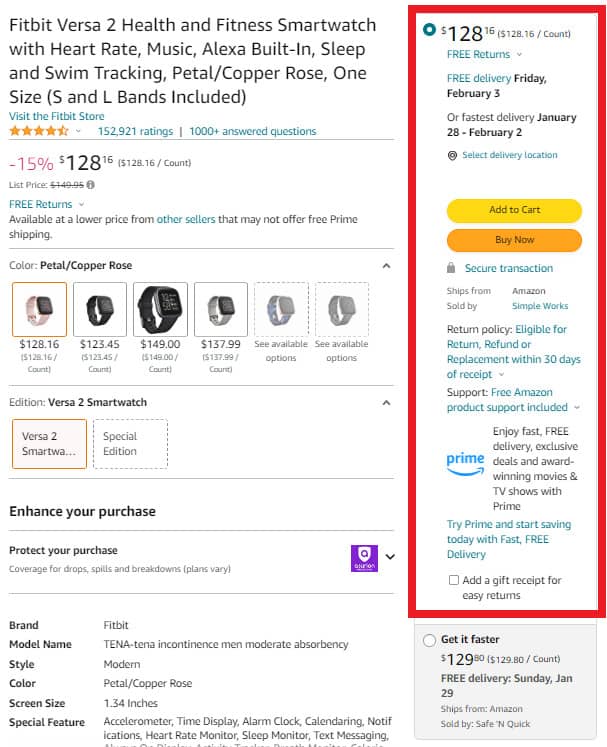
If you want to make sales — and you don’t have an incredibly unique item — you’ll want to offer free shipping as much as possible.
Struggling to beat Amazon at its own game? Check out these other recommended tips for competing with Amazon as an eCommerce business.
Inflow’s Best in Class Research Report: Our 2024 Findings on Shipping & Returns
At Inflow, we are big believers in data. If you’re paying attention to people’s opinions about eCommerce shipping best practices — as well as for search engine optimization (SEO), conversion rate optimization (CRO), and more — you’ll find that they often contradict each other.
Data cuts through the noise and shows what really works.
That’s the rationale behind our Best in Class research report: Learn what the top eCommerce sites are doing so that we can emulate them and help our clients become more successful.
Each year, we collect nearly 200 data points about 10 top eCommerce sites. Conducting this report annually lets us spot trends, so we can better understand how the eCommerce ecosystem is evolving.
Below, we’ll share some of our top findings regarding shipping and returns — but you can always download the full Best in Class Report for yourself to see the complete collected data.
90% of Top Retailers Provide Free Shipping
Free shipping is the standard for brands today. If you want to compete not just with Amazon, but with the other eCommerce sites in the marketplace, you need to be prepared to offer some form of free shipping.
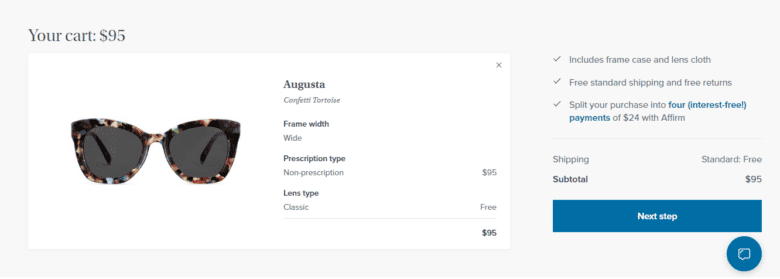
That said, only a few of our studied sites that offer free shipping offer free shipping on all orders (20%, to be exact).
Instead, most retailers choose to offer thresholded free shipping: free shipping on orders over a certain price, such as the $35 minimum selected by Wayfair.
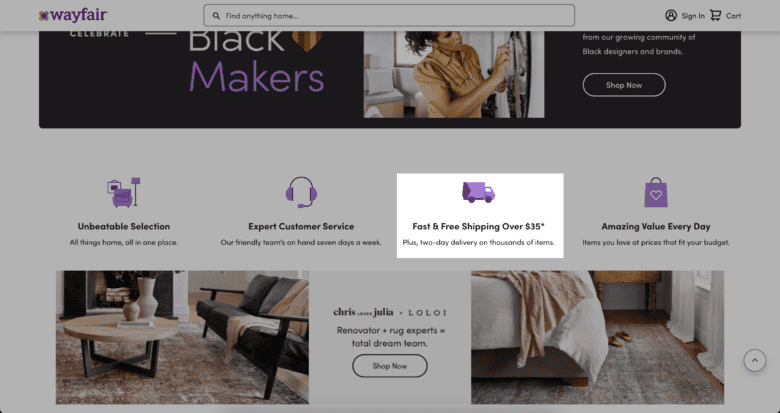
This shipping strategy can be an effective way to increase average order value (AOV), and it ensures that free shipping is profitable for your business.
But Only 50% Provide Free Returns
Free returns are much less popular than free shipping among eCommerce sites. Only half of the major retailers in our 2024 Best in Class Report do this.
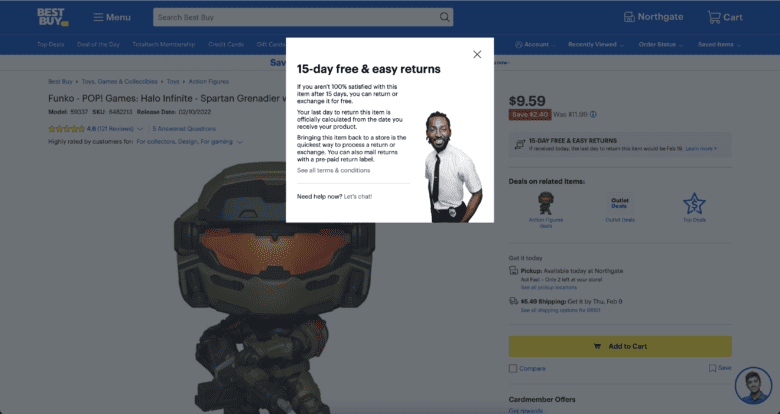
Free product returns are less popular for many reasons — mainly, that it adds costs to your eCommerce business.
You have to supply a shipping label for the merchandise and then decide what to do with the returned products. At a minimum, this means restocking the item for sale, but the item might be damaged, defective, or poorly repackaged, making it unsuitable for resale.
The fact that free return shipping is not universal means your brand can gain a competitive advantage in a crowded marketplace by offering this benefit. (We’ll discuss factors to consider in setting your eCommerce return policy below.)
Best Practices for eCommerce Shipping & Returns in 2024
Looking at our analysis of modern shipping and returns practices and comparing them against our own testing experience, we have a few recommendations for how to handle these services on your eCommerce site.
1. Offer Full Free Shipping
If you want to convey that your brand is one of the elite premium brands, you have to offer full free shipping.
In this year’s Best in Class analysis, only two brands offer full free shipping to customers: Nike and Temu. Nike has made its name as a premium athletic retailer for decades, but Temu’s case is even more interesting. While not a “premium” brand per se, its choice to offer full free shipping certainly contributed to its meteoric rise as an online marketplace — so much so that app downloads surpassed those of Amazon in 2024.
Bottom line: If you’re trying to establish your eCommerce brand as a premium label or significantly grow your marketplace presence, completely free shipping is often the way to go.
However, if your eCommerce store can’t make the numbers work, thresholded free shipping is a viable alternative. Evaluate your profit margins to determine what threshold makes sense for you.
Another compromise is free shipping for members. Choosing this shipping option will help you capture more emails for your list, but you have to be sure that it will be worth it to you.
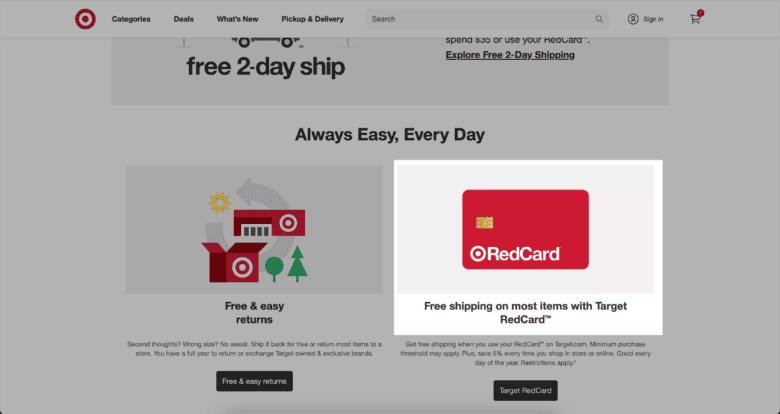
Nearly half of Amazon Prime members buy from the platform at least once a week. If you could turn members into repeat customers like that, it might be worth it, but you have to be realistic about your sales prospects.
2. Consider Free Returns
Online shoppers know that they don’t have all the information about the product they’re buying. They haven’t touched it or seen the actual color with their own eyes. They haven’t tried it on.
This means that they’re more likely to have to return it.
That return risk represents real costs for a potential customer: the money and hassle it takes to ship a product back. Offering free eCommerce returns reduces this worry for your customers. However, it also represents a huge cost for your business.
Determining whether the cost is worth it for your eCommerce brand can be complicated.
One interesting case is Lululemon. Like Target, they offer free customer returns. They don’t have the same volume of sales that Target has, so they’re not able to spread out the cost of returns as easily. Plus, they operate within the women’s apparel vertical, one with a high rate of returned items, so they might be facing an enormous expense.
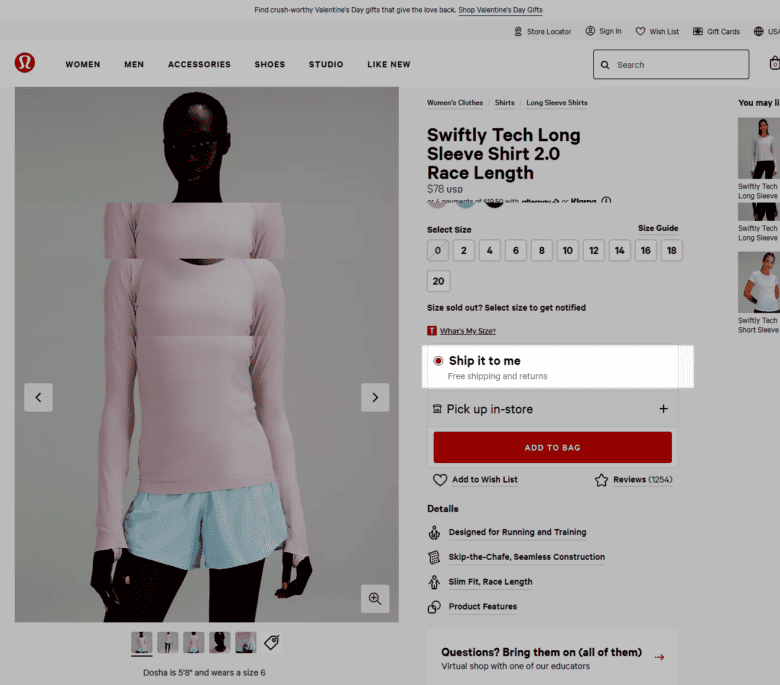
However, Lululemon’s high-quality merchandise offers high customer satisfaction to keep their number of returns down. They receive about one-quarter as many returns as comparable businesses, which helps them afford free returns.
As a result, offering free returns helps build confidence in the minds of potential customers, fueling Lululemon’s rapid growth.
To decide if free online returns are right for your brand, ask yourself these questions:
Does my brand provide sufficient assurance to shoppers?
Trust is a big obstacle for online shoppers. A potential customer at your online store has to decide if they trust that you’re actually delivering the quality of product that they’re looking for. Otherwise, they know they’ll have to return the product, which represents additional cost and nuisance.
Free returns can provide assurance to customers who want to try your product but might have doubts about it. If you have a quality product that will win shoppers over but have a weak brand, free returns can be a huge boon to your sales and your revenue.
Am I in a vertical that needs more assurance?
Not all items are at equal risk of return. Although the actual numbers differ, multiple sources agree that apparel has one of the highest — if not the highest — rate of returns.
People know that buying apparel or electronics online is a risk, so they are looking for assurance. Free returns can give them that reassurance to commit to those online purchases.
Can I afford free returns?
Free returns can be a big potential expense for a small business. Not only is there the cost of return labels and shipping, but you also have the expense of refunding the purchase price, plus restocking the item or writing it off.
Free returns can also lead to an increase in requested refunds. People might buy items with the intent to return them or even attempt return fraud.
Make sure to streamline your returns process before offering free returns. The returns experience has a big impact on whether shoppers decide to buy again. The lifetime value of customer retention is often more than any single purchase.
If you are considering offering free returns, also consider implementing in-store features and customer support that can reduce high return rates. Focus on providing hassle-free returns that are easy for your customers to navigate, and the initial investment will be well worth it.
In fact, improving this part of the customer experience can pay for itself by reducing your eCommerce return rate.
Can I try a limited test?
If your answers to the above questions aren’t clear, collecting data might be the only way to figure out the right solution for your eCommerce store. Test the free returns alternative and see what it does to your bottom line.
Our CRO team can implement a free-returns testing program customized for your eCommerce site, products, and budget. Contact us today to learn more.
3. Create Detailed Shipping & Return Policies
When you decide on your shipping and return policies, take into account as many different situations as possible, and then write clear policies for those situations.
Describe these policies in detail on your eCommerce website, anticipating as many of your customers’ questions about the shipping process as possible, including:
- What are delivery times like? Do you have expedited delivery options, such as same-day delivery? How much does that cost?
- What shipping carriers do you use? Are your packing materials recyclable?
- How does tracking work? What happens if I misplace my tracking number?
- What countries do you ship to? Does free shipping cover international shipping?
- How does the return process work?
- Will I receive cash back or store credit?
- What is the returns window?
- What happens if my product breaks? What if it’s out of stock?
- How do I start the returns process? How long does it take?
- Are there restocking fees?
If a situation comes up that you don’t anticipate, decide on a policy, and then add it to your policies page or FAQ.
Making your shipping and return policies clear upfront helps build trust to overcome potential buyers’ objections to purchase. It also helps manage customer expectations, which will increase customer satisfaction.
4. Highlight Your Shipping & Return Policies on Your Site
If you decide to use free shipping and returns to improve your sales, you have to make sure shoppers understand that you offer this benefit. Otherwise, these policies can’t influence purchase decisions and give you the sales bump you’re hoping for.
Simply promoting favorable shipping and returns policies can give you a significant sales bump. For one of our clients, highlighting their free shipping and returns policy — which had always been their policy — on their global navigation menu lifted their sales by 20%.

It’s not just as easy as putting “free shipping” in your banner, though.
Finding the right placement that ensures your customers get the message — and you get the sales — can take some testing. An expert CRO team can help you identify how to maximize these benefits from your existing policies.
Incorporate Free Shipping & Returns into a Holistic CRO Strategy
There’s no doubt that Amazon has transformed the eCommerce landscape with respect to shipping and returns. Our 2024 Best in Class research shows that offering some form of free shipping is no longer optional for eCommerce companies that want to remain competitive in a crowded marketplace.
Free returns, on the other hand, can be a more strategic decision, one that will depend on aspects of your brand, your products, and your profitability.
Of course, shipping and returns are just two parts of an overall CRO strategy. You can download our full Best in Class Report below to learn more about how today’s top eCommerce brands build their eCommerce shipping strategy.
Download Our eCommerce Best in Class 2024 Report Now.
If instead you’d rather have CRO experts help develop a conversion optimization strategy for your eCommerce brand, our team can create a personalized testing strategy to evaluate what you’re doing now and find the most effective way forward.
Interested? Contact us today to request a free strategy proposal for your website.












Thanks for breaking down the complexities and offering practical strategies.